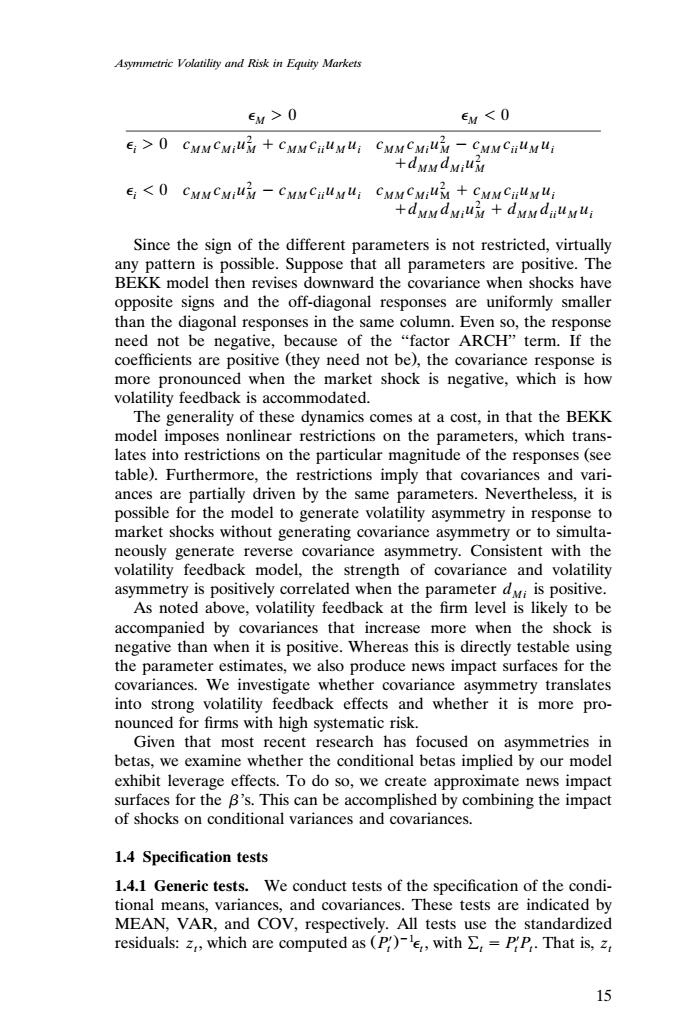正在加载图片...

Asymmetric Volatility and Risk in Equity Markets EM>0 ∈M<0 Ei>O CMMCMiuM CMMCiiumui CMMCMiuM -CMMCiumui +dMmdMiuM E<CMMCMiuM -CMMCiuMu:CMMCMiuM+CMMCiumui +dmudmiuy dmmdiiumui Since the sign of the different parameters is not restricted,virtually any pattern is possible.Suppose that all parameters are positive.The BEKK model then revises downward the covariance when shocks have opposite signs and the off-diagonal responses are uniformly smaller than the diagonal responses in the same column.Even so,the response need not be negative,because of the "factor ARCH"term.If the coefficients are positive (they need not be),the covariance response is more pronounced when the market shock is negative,which is how volatility feedback is accommodated. The generality of these dynamics comes at a cost,in that the BEKK model imposes nonlinear restrictions on the parameters,which trans- lates into restrictions on the particular magnitude of the responses (see table).Furthermore,the restrictions imply that covariances and vari- ances are partially driven by the same parameters.Nevertheless,it is possible for the model to generate volatility asymmetry in response to market shocks without generating covariance asymmetry or to simulta- neously generate reverse covariance asymmetry.Consistent with the volatility feedback model,the strength of covariance and volatility asymmetry is positively correlated when the parameter dyi is positive. As noted above,volatility feedback at the firm level is likely to be accompanied by covariances that increase more when the shock is negative than when it is positive.Whereas this is directly testable using the parameter estimates,we also produce news impact surfaces for the covariances.We investigate whether covariance asymmetry translates into strong volatility feedback effects and whether it is more pro- nounced for firms with high systematic risk. Given that most recent research has focused on asymmetries in betas,we examine whether the conditional betas implied by our model exhibit leverage effects.To do so,we create approximate news impact surfaces for the B's.This can be accomplished by combining the impact of shocks on conditional variances and covariances. 1.4 Specification tests 1.4.1 Generic tests.We conduct tests of the specification of the condi- tional means,variances,and covariances.These tests are indicated by MEAN,VAR,and COV,respectively.All tests use the standardized residuals:z,which are computed as(Pe,with =P'P.That is,z 15Asymmetric Volatility and Risk in Equity Markets M M 0 0 2 2 i MM Mi M MM ii M i MM Mi M MM ii M i 0 c cu c cu u c c u c cu u 2 d du MM Mi M 2 2 i MM Mi M MM ii M i MM Mi 0 c cu c cu u c c uM c cu u MM ii M i 2 d du MM Mi M MM ii M i d du u Since the sign of the different parameters is not restricted, virtually any pattern is possible. Suppose that all parameters are positive. The BEKK model then revises downward the covariance when shocks have opposite signs and the off-diagonal responses are uniformly smaller than the diagonal responses in the same column. Even so, the response need not be negative, because of the ‘‘factor ARCH’’ term. If the coefficients are positive they need not be , the covariance response is Ž . more pronounced when the market shock is negative, which is how volatility feedback is accommodated. The generality of these dynamics comes at a cost, in that the BEKK model imposes nonlinear restrictions on the parameters, which translates into restrictions on the particular magnitude of the responses see Ž table . Furthermore, the restrictions imply that covariances and vari- . ances are partially driven by the same parameters. Nevertheless, it is possible for the model to generate volatility asymmetry in response to market shocks without generating covariance asymmetry or to simultaneously generate reverse covariance asymmetry. Consistent with the volatility feedback model, the strength of covariance and volatility asymmetry is positively correlated when the parameter dM i is positive. As noted above, volatility feedback at the firm level is likely to be accompanied by covariances that increase more when the shock is negative than when it is positive. Whereas this is directly testable using the parameter estimates, we also produce news impact surfaces for the covariances. We investigate whether covariance asymmetry translates into strong volatility feedback effects and whether it is more pronounced for firms with high systematic risk. Given that most recent research has focused on asymmetries in betas, we examine whether the conditional betas implied by our model exhibit leverage effects. To do so, we create approximate news impact surfaces for the ’s. This can be accomplished by combining the impact of shocks on conditional variances and covariances. 1.4 Specification tests 1.4.1 Generic tests. We conduct tests of the specification of the conditional means, variances, and covariances. These tests are indicated by MEAN, VAR, and COV, respectively. All tests use the standardized Ž .1 residuals: z , which are computed as P , with Ý P P . That is, z t t t t tt t 15���������